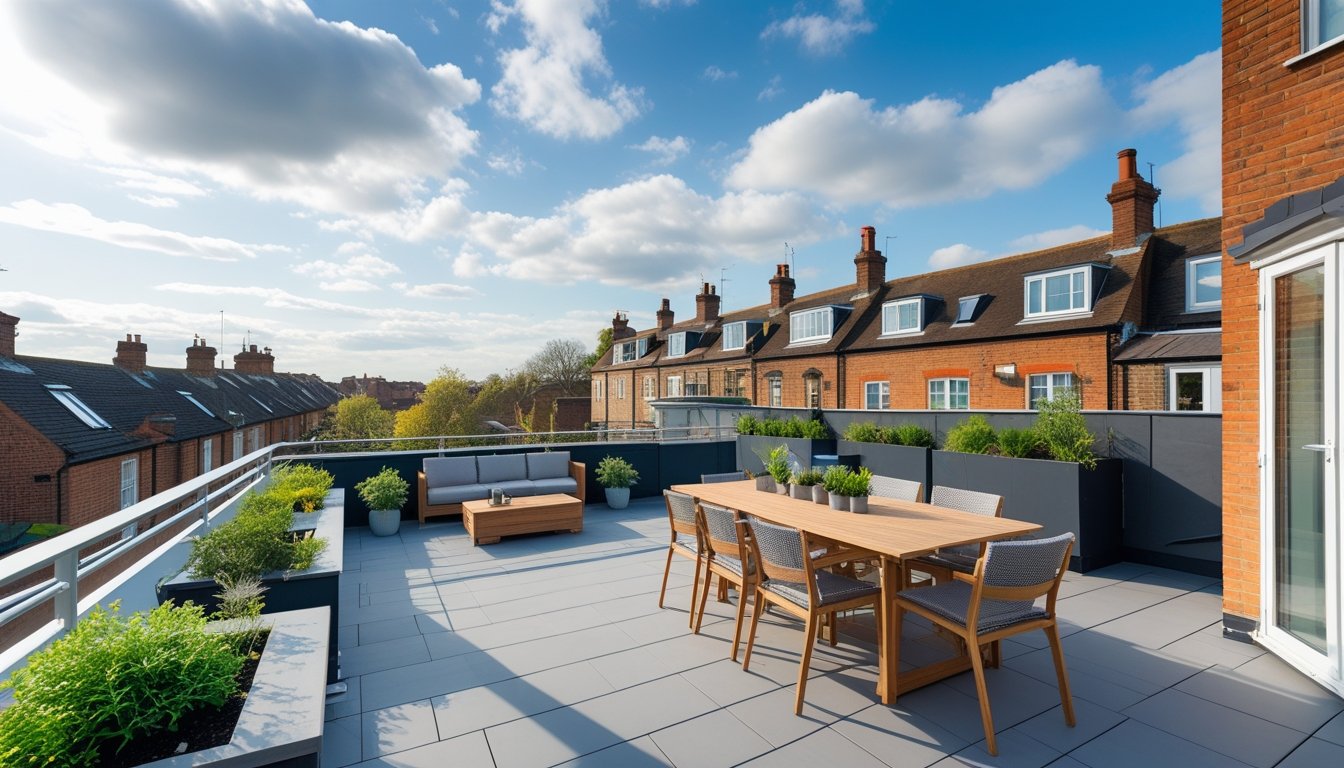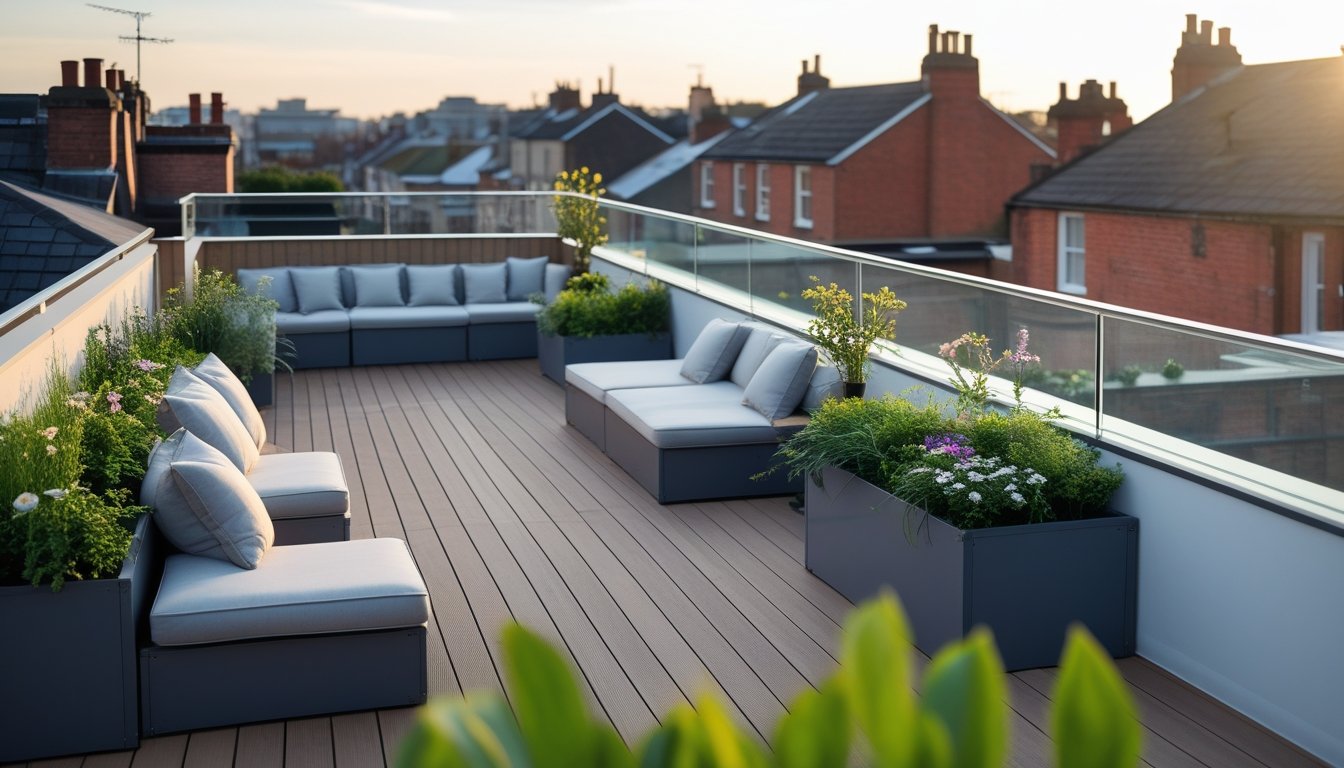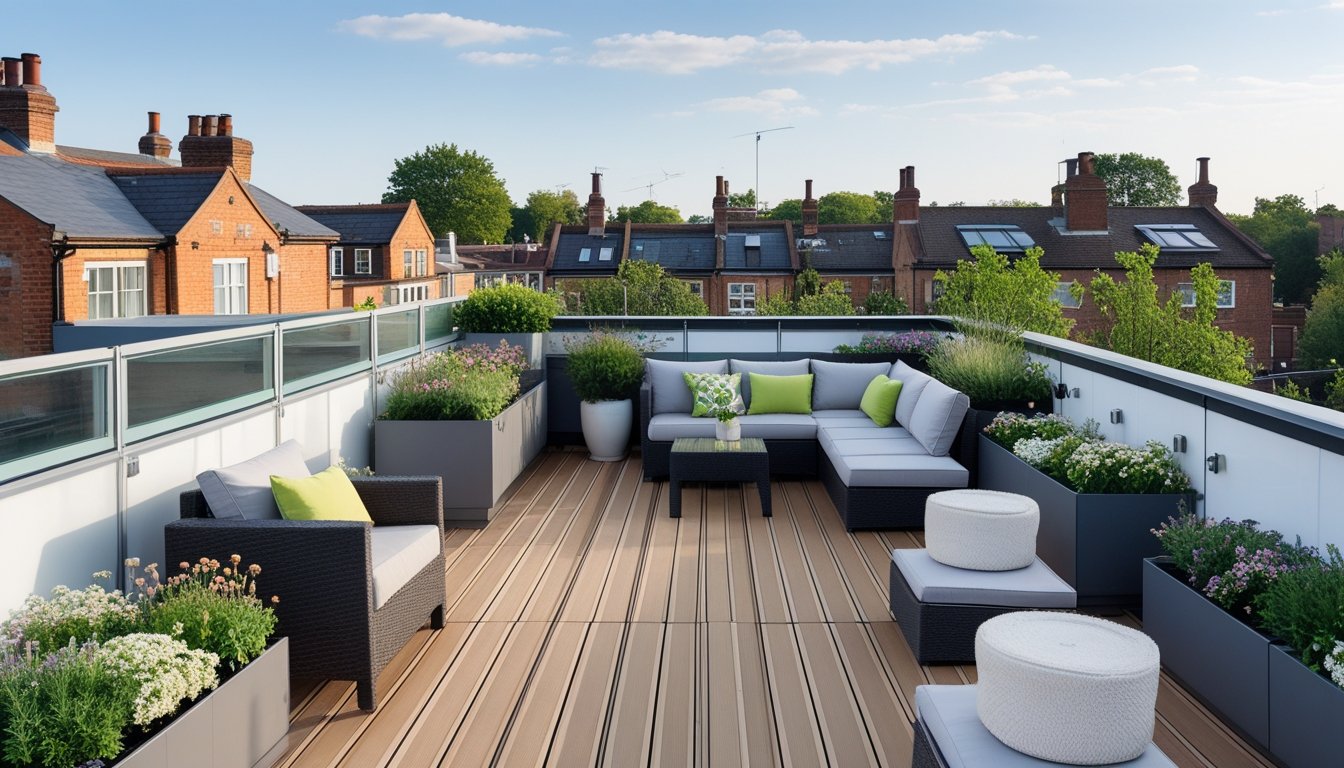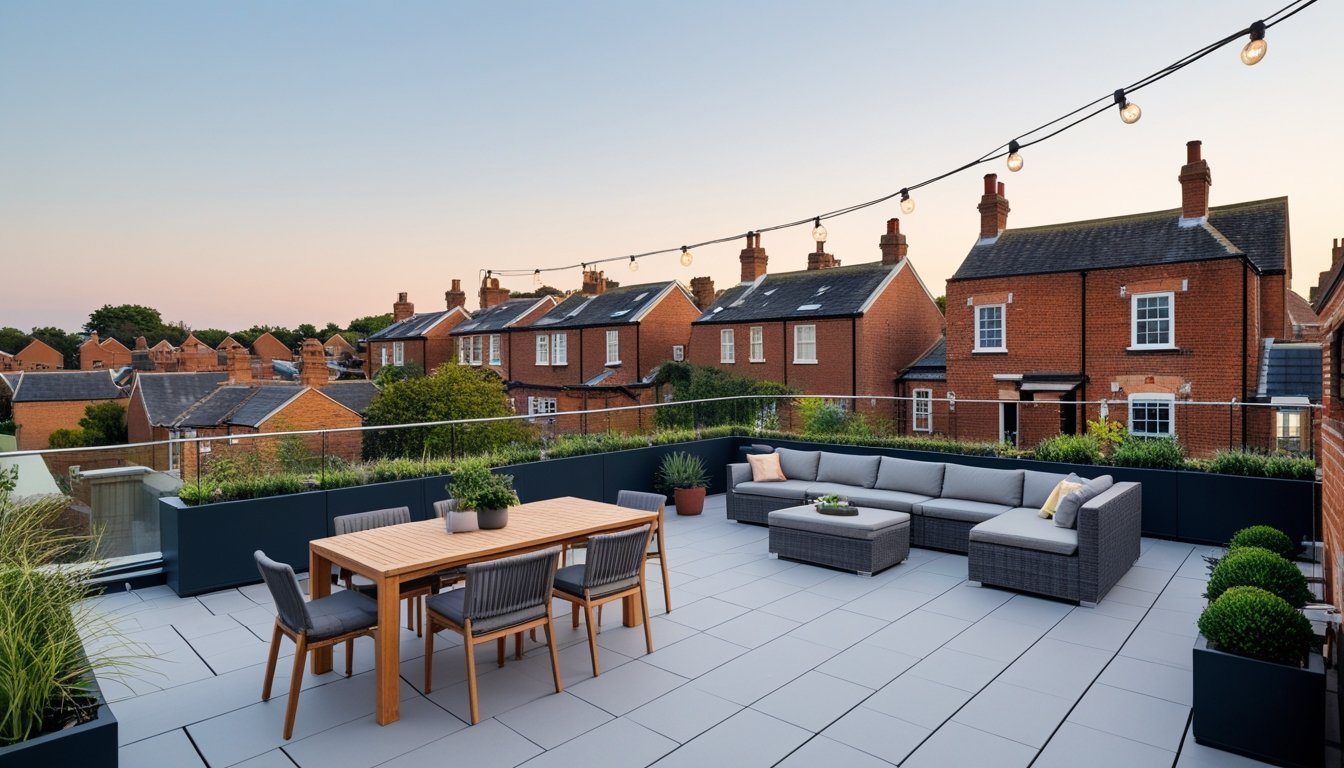Late updated: 14 Jul 2025 18:07
Written by: Oliver Bennett
Creating Functional Roof Terraces for UK Homes: Enhancing Urban Living Spaces
Creating functional roof terraces for UK homes is an exciting way to add value and additional living space to a property. With the demand for outdoor urban spaces rising, a well-designed roof terrace can serve as an oasis for relaxation and entertainment. Design elements such as green terraces, practical furniture, and climate considerations are essential for creating a versatile and enjoyable rooftop environment.

As we consider transforming our rooftops, we're aware of the potential to redefine our living areas, providing benefits such as increased home value and enhanced lifestyle opportunities. Understanding planning regulations and necessary building requirements will be crucial in ensuring both functionality and compliance. By thoughtfully incorporating smart design features, roof terraces can become stylish and efficient extensions of our homes.
Key Takeaways
- Functional design enhances roof terrace versatility.
- Planning regulations must be considered carefully.
- Creative features provide additional value and enjoyment.
Key Principles Of Creating Functional Roof Terraces

When designing a functional roof terrace for UK homes, several principles are critical. Site-specific assessments, understanding regulations, and differentiating between various types of rooftop spaces are key areas that must be addressed. Additionally, it's important to consider the microclimate and weather factors that affect usability and durability.
Site Assessment And Structural Considerations
Before embarking on the creation of a roof terrace, the first step is to assess the site carefully. This assessment involves evaluating the structural integrity of the existing structure to ensure it can support the additional load. A structural engineer should be consulted to confirm that weight limits are not exceeded, especially considering elements like planters, furniture, and people.
Site assessment also includes evaluating access routes, as easy and safe access is essential for both construction and everyday use. A roof terrace must also account for privacy and view considerations. Potential solutions may involve installing screens or planting to shield from neighbouring views while optimising attractive vistas.
Building Regulations And Planning Permission
Compliance with building regulations and obtaining the necessary planning permissions are crucial in the construction of a functional roof terrace. UK building regulations require that roof terraces adhere to specific guidelines regarding safety, fire resistance, and energy efficiency. We must ensure our design is compliant with these requirements, which may include balustrades and non-slip surfaces.
Local planning authority permissions might also be needed, especially if the terrace will alter the silhouette of the building or impact neighbours' views. It's vital to verify restrictions on listed buildings or those in conservation areas. Consulting with local authorities during the design phase can streamline this process and prevent any legal obstacles.
Roof Terrace Versus Roof Garden And Green Roof
Understanding the distinction between a roof terrace, roof garden, and green roof can guide your design process. A roof terrace generally features patios or deck areas, creating an open living space primarily for leisure activities and entertainment. In contrast, a roof garden incorporates planted areas and might focus more on integrating with nature.
A green roof goes further, prioritising environmental benefits like thermal insulation and biodiversity. In creating a roof terrace, integrating elements from roof gardens or green roofs, such as planter boxes or green walls, can enhance aesthetics without compromising the terrace's primary functional role. Each option has specific design implications that should be considered before construction begins.
Microclimate And Weather Management
Successfully managing the microclimate and weather is fundamental to creating a versatile roof terrace. Roof terraces in the UK must endure a range of weather conditions, which means we should incorporate solutions such as windbreakers, shade structures, and drainage systems for rainwater management.
The choice of durable and weather-resistant materials is essential for surfaces and furnishings. Factors such as sun exposure, wind patterns, and precipitation must be considered to protect against damage and ensure comfort. Designing flexible solutions, such as retractable awnings or adjustable screens, can maximise usability in varied weather conditions, making the terrace functional year-round.
Design Features And Practical Solutions For UK Roof Terraces

Roof terraces offer unique opportunities to transform unused spaces into functional areas. We’ll explore effective planting strategies, use of spaces through zoning, selecting appropriate furniture, and ensuring year-round usability with lighting and heating.
Effective Planting And Green Spaces
Incorporating green spaces like miniature gardens or vertical gardens can elevate the aesthetic and environmental value of roof terraces. Using native plants such as heather can enhance biodiversity and thrive in the UK climate.
Container gardens are adaptable, allowing easy rearrangement and maintenance. Selecting hardy perennials ensures year-round greenery, while dwarf shrubs can add structure. Strategically placed planters provide privacy and can create a more secluded environment, essential for high-rise terraces.
Optimising Outdoor Spaces With Zoning
Zoning is key to maximizing the functionality of roof terraces. By dividing the space into distinct areas for relaxation, dining, and entertainment, we create an adaptable and versatile use of space.
Using planters or railings as natural dividers helps define each zone without closing off the open-air environment. This approach maintains a seamless flow while enabling multiple activities. Incorporating features like small patios or outdoor rugs can further delineate spaces and enhance comfort.
Seating, Containers, And Furniture Selection
Choosing the right furniture can significantly impact the usability and comfort of a roof terrace. Modular seating is an excellent choice for its flexibility, allowing reconfiguration based on the occasion.
Eco-friendly materials like recycled plastic or sustainably sourced wood can reduce environmental impact. Opting for multi-purpose furniture like benches with storage combines functionality with practicality. When selecting containers, consider weather-resistant and durable options to withstand typical British weather conditions.
Lighting, Heating, And Year-Round Usability
Proper lighting and heating solutions are crucial for making roof terraces usable throughout the year, especially given the unpredictability of UK weather. LED string lights or solar-powered lamps provide sustainable lighting options that enhance ambience without increasing energy consumption.
For heating, infrared heaters or portable fire pits offer effective warmth, making outdoor spaces more inviting during cooler months. By incorporating adjustable coverings like retractable awnings, we can extend usability through rain and shine. This ensures that our terrace remains a welcoming retreat, regardless of the season.
Frequently Asked Questions

Creating a functional roof terrace in the UK involves addressing practical design elements, incorporating greenery, and considering structural integrity. Whether you're envisioning a terrace adorned with vibrant plant life or aiming for an efficient urban garden, thoughtful planning is essential.
What are the essential considerations when designing a garden on a small rooftop?
Creating a garden on a small rooftop requires maximising space. We should use lightweight planters and tiered arrangements to add depth without overwhelming the area. Ensuring proper drainage is crucial to avoid water-related issues. Moreover, selecting plants suited to rooftop conditions, including exposure to wind and sun, enhances the garden's success.
How can one incorporate greenery into modern rooftop terrace designs?
Greenery can transform a terrace into a serene escape. We should integrate a mix of planters, vertical gardens, and trellises. Adding potted trees or shrubs can provide privacy and a sense of enclosure. Vertical installations, like climbing plants, maximise space and contribute to a modern aesthetic.
What are economical ways to enhance a rooftop terrace?
Enhancing a rooftop terrace doesn’t have to break the bank. Opting for multi-purpose furniture, such as benches with storage, optimises space and utility. Upcycling old materials like pallets for seating or decking adds character. We should focus on DIY projects and sourcing second-hand items to maintain affordability.
What are the structural requirements for establishing a rooftop garden?
Establishing a rooftop garden demands careful attention to structural integrity. Consulting with a structural engineer is essential to ensure the building can support the additional weight. We ought to install waterproof membranes to prevent leaks. Adequate support for heavy planters is a must to maintain both safety and longevity.
How can one create a vegetable garden on a rooftop space?
Creating a vegetable garden on a rooftop offers fresh produce from home. We start by selecting lightweight containers and ensuring adequate drainage. Utilising raised beds can boost plant health and yield. Choosing compact plant varieties and focusing on vertical growth techniques utilises space efficiently while providing ample harvest.
What elements are key to forming a visually pleasing and functional roof terrace?
Key elements for a visually pleasing terrace include cohesive design choices and functional furniture. We should focus on selecting materials that can withstand the weather while offering comfort. Adding mood lighting can extend terrace use into the evening. Incorporating levels or partitions adds interest and clearly defines spaces for different activities.
